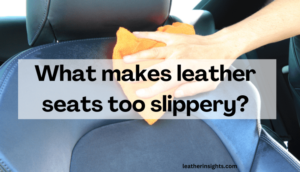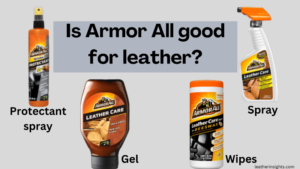How to Stop sliding on Leather Car Seats
Are you tired of constantly sliding around in your leather seats while driving? Many car owners with leather car seats struggle with this issue so it’s quite common.
Whether it’s due to the type of leather used, the age of the seats, or even the products used to clean or protect them, the issue of leather seats becoming too slippery is quite frustrating.
So in this article, we will look at the things that cause leather car seats to lose their grip and offer some practical solutions on how to stop sliding on leather car seats

What makes leather seats too slippery?
If your leather seats are too slippery, it could be they have been treated with a leather product like a protectant or conditioner that has not fully been absorbed or wiped off. The product can leave a slick residue on the surface of the seats making them slippery.
Other causes might include;
-
The leather seats are dirty
A dirty or greasy surface on the leather seats can certainly contribute to them becoming slippery and making the leather sticky.
If the seats are not cleaned regularly, dirt and debris can accumulate on the surface of the leather, making it more difficult to maintain a grip.
In addition, if any oils or greasy substances are allowed to build up on the seats, they can make the surface even more slippery.
-
Cleaning products
Cleaning products, especially those that are not specifically designed for use on leather such as baking soda, can strip the leather of its natural oils and make it smooth.
When the oils are removed, the leather becomes dry and brittle, which can cause it to lose its grip.
Additionally, using cleaning products that contain harsh chemicals or abrasives can damage the surface of the leather, making it smoother and slicker.
Some cleaning products also contain silicones which can give the leather a slick feel.
It is therefore important to use cleaning products that are specifically designed for use on leather and to follow the manufacturer’s instructions for use.
-
Leather protectants and polish
Leather protectants are usually designed to protect and nourish leather furniture in order to keep it supple and prevent cracking and fading.
However, some protectants can make leather slip especially if they contain silicone and other substances that can leave a slippery residue on the surface of the seat.
This is why it is advisable to specially use cleaning products designed for leather and to follow the instructions given by the manufacturer when applying them.
-
Sweating
Sweating is a common problem during hot weather and can make you slip on your leather seats.
This is because when we sweat, our skin produces oils and moisture, which can transfer to the leather seats making the surface slippery.
Additionally, sweat causes a bad odor on the leather that can linger for months if the seats are not cleaned properly. This particularly happens if the leather car seats are not protected by a good quality leather protector that can repel moisture and bacteria.
-
Wearing certain types of clothing
The slipperiness of your leather seats can also be caused by the type of clothing you wear.
Certain materials, such as silk or satin, can be more slippery than others, such as cotton or denim. Also, clothing that is tight-fitting or form-fitting can be more likely to slide on the surface of the seat.
Additionally, if you are wearing clothing that has been treated chemically, with oils or with fabric softeners, those substances may transfer to the leather seats and make the surface slippery.
-
Personal grooming products
Your personal grooming products like hair oil, sprays, and gels can make the seats slippery if they transfer to the leather.
Similarly, skin care products like creams and lotions contain oils that can also transfer to the leather seats and make them slick.
How to stop sliding on leather car seats
Sliding on leather car seats can be annoying and even dangerous, as it can affect your driving and cause discomfort.
Luckily, there are several ways to prevent sliding on leather car seats:
1. Use seat covers
Seat covers are a good option for protecting leather seats from wear, tear, and stains as well as provide extra grip to help prevent sliding on the seat.
There are different types of seat covers available but you should choose the ones designed specifically for leather seats as they may be less likely to damage the leather.
Some car seat covers are made of breathable materials like cotton or mesh, which can help to wick away moisture and keep the seat cool. This can be especially useful in hot weather when sweating can make the seat slippery.
There are also seat covers made of synthetic materials that can mimic the look and feel of leather and add an extra layer of protection to the seats.
It’s important to choose seat covers that fit well; seat covers that are too big or too small can shift and make the seat slippery.
2. Use non-slip spray
A non-slip spray for leather is a product that is specifically designed to increase grip and reduce slipperiness on leather surfaces such as seats in cars, furniture, and shoes.
These sprays typically contain a whole range of ingredients that create a rough texture on the surface of the leather thereby increasing the friction and reducing the slipperiness.
However, it is important to point out that the safety of non-slip sprays for leather may vary depending on the specific product and its ingredients.
Some sprays may contain chemicals that can be harsh or toxic and may cause damage or discoloration to the leather over time. So you should read the label and the manufacturer’s instructions carefully before using it.
Additionally, they are also not a permanent solution to leather slipperiness. Consider regular cleaning and conditioning of your seats in order to maintain the leather grip.
3. Clean with isopropyl alcohol
Using isopropyl alcohol to remove slipperiness on leather car seats can be an effective solution.
Isopropyl alcohol is actually a common ingredient in many cleaning solutions and can be used safely in small amounts on leather.
Using it on leather can help to break down oils and other substances that can make the seats slippery.
However, it should be diluted with water to lower its strength and prevent it from drying out the leather which can lead to cracking and peeling.
Also, it is important to apply a leather conditioner after cleaning with Isopropyl in order to restore the natural oils and the suppleness of the leather.
4. Clean with vinegar and neatsfoot oil
Vinegar can also be used to clean leather and but it’s important to use it in the right concentrations so as not to damage your leather seats.
It’s important to use a mild solution such as a mixture of equal parts water and white vinegar, as stronger concentrations of vinegar can be harsh on the leather and can cause discoloration or damage over time.
Diluted white vinegar can be safe to use on leather as it can help to clean and remove dirt, grime, and sweat from the surface.
Additionally, vinegar can strip away oils and waxes on the leather surface and thereby get rid of the slipperiness. This however leaves the leather dry and needs to be conditioned in order to restore the natural oils and moisturize it.
To avoid this, you can mix vinegar with suitable leather oil such as neatsfoot oil.
5. Apply leather sealant for car seats
Applying a sealer to leather seats can help to lessen their tendency to slide around because it can create a barrier on the surface of the leather that increases friction and grip.
However, it’s important to use a sealant that is specifically formulated for use on the leather since there are different types.
There are silicone-based sealants, acrylic-based sealants, and polyurethane-based sealants. These sealants create a barrier on the surface of the leather that can help to increase the grip as well as protect the leather from stains, spills, and UV rays.
Whichever you choose, remember to first test it on a small inconspicuous area on the seats to ensure it doesn’t cause any adverse effects.
Also, note that silicone-based products can be harsh on leather and may cause discoloration so it’s good to avoid them especially when the leather is treated with waxes and oils.
6. Use a non-slip seat cushion
There are many types of seat cushions that are specifically designed to provide more grip and stability on leather seats.
These cushions usually have a rubberized bottom or other non-slip material that sticks to the leather, while the top is comfortable and supportive.
You can find them online or in stores that sell car accessories. If you are shopping for one, the Gorilla Grip Tufted Memory Foam Chair Cushion is a good example of a non-slip seat cushion that can help prevent slipping on leather car seats.
These cushions are made of high-density memory foam that conforms to your body and provides pressure relief.
The bottom is covered with a non-slip rubberized material that keeps the cushion in place while the top is tufted for added comfort and style.
The cushion comes in various sizes and colors and is suitable for cars, trucks, and other vehicles.
How to keep car seats from sliding on leather seats
Your baby’s car seat could be sliding on your leather seats due to improper installation, smooth leather surface, weight distribution in the car seat, vehicle design, and poor fit.
Whatever the cause, it’s important to consult a certified car seat technician or specialist in your area. The specialist will determine the cause of the sliding and help you fit the car seat into your vehicle correctly.
You can also take the car seat to your local fire department and you will get assistance.
Conclusion
In conclusion, slippery leather seats can be a common problem for car owners.
There are several factors that can cause leather seats to become slippery, such as sweating, oils and other substances that can make the seats slippery, and even the type of clothing that you wear.
However, there are several ways to address this issue such as using seat covers, using non-slip sprays, applying sealant, and cleaning the leather using diluted vinegar or isopropyl alcohol and conditioning it.
Before using these products, always remember to test them on an inconspicuous part of the seats to ensure they don’t cause any damage.




